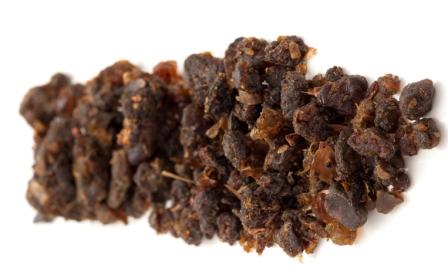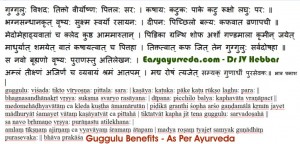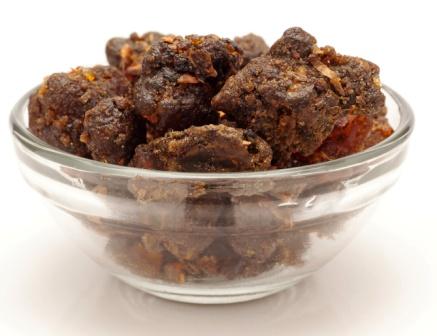Guggul Benefits, Usage, Dose, Side Effects, Research
Guggul is one of the most used Ayurvedic herbs. Its oleo-gum resin is used as a binding agent in many tablets. Guggulu’s unique properties of decreasing cholesterol level and relieving joint inflammation find it as an essential ingredient of numerous Ayurvedic medicines.
Botanical name – Commiphora mukul,
Burseraceae family. (Guggulu kula)
Other botanical names – Commiphora wightii, Commiphora roxburghii, Balsamodendron Mukul
Table of Contents
Synonyms
English name: Indian bedellium, Indian bdellium
Synonyms:
Devadhupa – Guggulu is also used in incense sticks to worship
Jatayu
kaushika – Exudes gum resin from its cavities
Pura – Guggulu is considered as best among niryasa
Kumbha, Ulukhala, Mahaneela
Mahishaksha – Gum resin of guggulu has reddish black colour like that of buffalo’s eye
Palankasha – Guggulu reduces obesity

Fracture healing property
Bhagnasandhaanakrut – Useful in quick bone healing during fracture and dislocation. Guggulu has enormous effect on musculo skeletal system.
It is a potent anti inflammatory herb, so it is helpful to relieve pain in muscles, joints, ligaments and bones
It strengthens bones and joints, so useful in fractures and dislocations. This is the reason, it is used in many medicines such as Lakshadi Guggul, which are quite commonly used in the treatment of fractures and dislocations.
Svarya – improves voice quality and strength
Anti-aging property
Rasayana – rejuvenative. This is another interesting fact about guggulu. It is anti-aging in nature. Hence most of the Guggulu tablets can be taken for quite a long period of time, ranging from few weeks to months.
Deepana – improves digestion
Balya – improves strength, tonic
Wound healing property
Vrana, apachi – heals wounds quickly.
Guggulu, being a very good anti-inflammatory herb, helps to heal wounds, and ulcers pretty quickly. This is the reason, it is one of the essential ingredients in many of the Ayurvedic medicines used in abscess and wound healing such asPanchatikta Guggulu Ghrita and Guggulutiktakam Kashayam
Medicinal properties
Rasa – Tikta (Bitter), katu (Pungent)
Guna (qualities) – Laghu (light to digest), Rooksha (dryness), Vishada (Brings clarity, clears channels), Sookshma (Minute), Sara – brings about movement.
The newly collected resin is oily and sticky.
Vipaka – taste conversion after digestion – Katu – pungent
Veerya – ushna – hot potency

Sugandhi – good aroma
Sulaghu – easy to digest
Sookshma – Minute
Teekshna (piercing)
Ushna – hot
Katu rasa – pungent taste
Katupaka – turns pungent after digestion
Sara – initiates movement of fluids.
Hrudya – good for the heart. It helps to lower cholesterol levels, it is a good rejuvenative, hence it is considered good for the heart.
Nava Guggulu
Fresh Guggulu (before one year) is
Snigdha (unctuous, oiliness)
Picchila – Sticky
Bruhmana – nutritious, improves body strength
Vrushya – aphrodisiac
Purana Guggulu
Gulgulu older than a year – is
Lekhana – blood thinning, scraping and clearing the channels.
It balances Tridosha.
Relieves bad odour, skin diseases and increases digestive diseases.
New Guggulu is aphrodisiac. But old Guggulu has scraping properties.
Identification
Identification characteristics of new and old Guggulu (Bhavaprakasha):
New guggulu is
Snigdha – unctuous, oily
Kanchana Sankasha – has golden yellow shine
Pakva Jambuphalopama – resembles ripe jamun fruit
Sugandhi – has good aroma
Picchila – Sticky, Slimy
Old guggulu is –
Shushka – dry
Durgandha – foul smelling
Tyaktaprakruti varna – will not have its original colour and nature
Guggulu for obesity
guggulu: medo anilaharanm | – caraka samhita, 25
Of all the herbs that are for obesity and to balance Vata, Guggulu is the best.
How to use guggulu for weight loss?
Dr JV Hebbar:
Guggulu has the below benefits, as per Bhavaprakasha Nighantu textbook, Karpooradi Varga section, verse – 37
मेदोमेहाश्मवातांश्च क्लेदकुष्ठाममारुतान् |
medomehāśmavātāṃśca kledakuṣṭhāmamārutān |
medo – guggulu decreases excess fat tissue in the body
meha – useful in urinary tract infections, diabetes
aśma – useful in kidney and bladder stones
vātāṃśca – Balances Vata Dosha
kleda – decreases excess body fluids and moisture
kuṣṭha – useful in deep seated skin diseases,
āmamārutān – useful in rheumatoid arthritis.
So, guggulu, being hot and piercing, burns the fat and is useful in obesity.
It is also useful in diabetes, so it is very useful in obese people who are also diabetic.
Obese people often have joint pain as the weight bearing joints of lower back and knee have to bear the extra weight. Guggulu balances Vata and is also useful to relieve joint pain.
Obese people are more prone to stroke, high cholesterol and blockage of arteries. Guggulu is also useful in reducing cholesterol.
Read: Guggul Benefits, Usage, Dose, Side Effects, Research
Standalone guggulu use:
Guggulu, when used alone, can cause an increase of heat. This increase of heat is useful in weight loss, as it burns the fat. But Guggulu, when used alone, can also cause heartburn or increased acidity in the stomach. In some people, it can cause constipation.
If the person does not have above complications, then a guggulu tablet – 300 – 500 mg, once or twice a day can be advised after food.
Read: Effective Obesity Treatment, Remedies, Ayurveda Tips
Guggulu – Herbal combinations
But if someone has constipation or heartburn, then A combination of Triphala with guggulu, called Triphala guggulutablet is available. This tablet – 2 – 6 tablets a day, in divided doses, after food is advised. Another option is Navaka Guggulu, which again contains Triphala, but it can be slightly hotter because it contains ginger, black pepper and long pepper.
If there is water retention along with obesity, as in case of hypothyroidism, then Punarnavadi gugguluis advised
If the obese patient has deep skin tissue disorders such as abscess, sinuses, etc., then Panchatikta ghrita gugguluis advised where Guggulu along with bitter herbs are administered in herbal ghee form. If the ghee form is not desired, then Saptavinshatika guggulucan be the alternative.
If the obese patient has low bone density, then Lakshadi gugguluis advised.
If the obese patient has varicose veins, gout etc. then Kaishor gugguluis advised.
If anemia, Panchamrit Loha Guggulu
If depleted immunity, ojas and weakness, then Swarna Mahayogaraj Guggulu
These are the different ways in which Guggulu or polyherbal combinations of Guggulu are selected.
Keep in mind that these tablets are often made into a combination with other medicines to enhance the anti obesity effect (For example, Varanadi kashayam, Triphala Churna) or to reduce the side effects – Such as administering with haritaki churna or low dose castor oil to relieve constipation. For the administration of the right form of guggulu, please consult an Ayurveda doctor.
Read: Obesity: Pathology, Signs And Symptoms As Per Ayurveda


Other uses
Medahara – lowers cholesterol.
Meha – useful in diseases of the urinary system and diabetes.
Kushta – useful in skin diseases. This is the reason it is an important ingredient in medicines like Amrutadi Guggulu, used to treat carbuncles, obesity and fistula.
Amavata – relieves rheumatoid arthritis.
Granthihara – relieves tumours, growths, warts
shopha – relieves inflammation
Arsha, – useful in piles. Hence it is the binding agent in Triphala Guggulu. Haemorrhoid patients often suffer from constipation. Triphala helps to relieve constipation, soothes the mucous layer and Guggulu helps in shrinking the size of the pile mass and to relieve inflammation.
Gandamala – useful in goiter. Hence it is an ingredient of – Kanchnar Guggulu, an Ayurvedic medicine used in treating goiter, nodules and thyroid problems.
Krumeen jayet – relieves intestinal worms and infested wounds.
Guggulu for hypothyroidism
Guggulu alone or many guggulu preparations such as Kanchanara guggulu, Triphala guggulu, Punarnavadi guggulu are extensively used for the treatment of hypothyroidism.
Effect of Gulgulu on Tridosha
Due to sweetness, it balances Vata.
Due to astringent properties, it balances Pitta
Due to bitter properties, it balances kapha. Hence Guggulu – Indian bedellium (gum resin) – Commiphora mukul brings about Tridosha balance.
Side effects
In people with sensitive stomach, Guggulu or Guggulu tablets may cause worsening of gastritis.
In pregnant ladies, any Ayurvedic medicines, including Guggulu as an ingredient is best avoided.
During lactation and for children, it is best to take Guggulu tablets only under strict medical supervision.
Interaction with medicines, supplements
Can this be used while taking Homeopathic medicine?
Yes. This product does not react with homeopathic medicine.
Can this medicine be continued while taking supplements like multivitamin tablets, Omega 3 fatty acids etc?
Yes. Generally, this product goes well with most dietary supplements. However, if you are taking more than one product per day, please consult your doctor for an opinion.
With western
medicines
Seek your
doctor’s advice if you are taking this product along with other western
(allopathic / modern) medicines. Some Ayurvedic herbs can interact with modern
medicine.
If both Ayurvedic and allopathic medicines are advised together, then it is
best to take Allopathic medicine first, wait for 30 minutes and then take the
Ayurvedic medicine.
Do’s and Don’ts while taking Guggulu
While taking Guggulu, it is best to avoid sour tasting food, (because, it may cause indigestion), Sex, strong physical activity, excessive sun exposure, alcohol consumption and anger.
Dosage
The dose depends basically on age. The dose varies from 125 mg to 1 gram.
Guggulu fumigation
Guggulu is used as a base to prepare fumigation. For this, 100 grams of Guggulu is added with 10 grams each of turmeric powder and neem powder, Cedarwood powder / oil (if available) – The mix is pounded together to make a stick. It is burnt and the fumes are inhaled. Or the entire home is fumigated as a method of disinfection.
It is especially done during pregnancy, delivery period and during lactation, to keep the room disinfected and clean.
Its fumes, inhaled moderately, is useful in relieving allergy, cold and cough.
Classical categorisation, Varieties
Charaka – Sanjna Sthapana – A group of herbs that are used to restore consciousness.
Sushruta and Vagbhata – Eladi group of herbs
Its references have been available since Vedic period. It is used for fumigation purposes. So the name Devadhupa.
Varieties: A textbook called as Bhavaprakasha mentions about 5 varieties of Guggulu as
Mahishaksha (black), Mahaneela(blue), Padma(Red), Kumuda(Kapisa) and kanaka(Yellow).
Commercial varieties
Grade 1 – Consists of translucent guggulu free from bark and sand
Grade 2 – Dull coloured variety mixed with guggulu
Grade 3 – Most inferior quality
Apart from Commiphora mukul, some Ayurvedic pharma companies do use Commiphora myrrha in the name of Guggulu.
Morphology
Shrub, 4- 6 feet height, branches knotty, crooked, ending in a sharp spine.
Leaves – 1 – 2 foliate, leaflet – sub sessile
Flowers – Seen in fascicles of 2 – 3 with very short pedicles
Fruits – Drupe
Seeds – Small, nuts, ovoid, Splitting in to two
Sthanika Karma (Systemic Action)
External – External application of its paste relieves pain, edema, promotes wound healing, It has Antimicrobial properties. Indicated in Joint disorders, Amavata (Rheumatic heart disease), Goiter, Inflammation in Lymph nodes, Various skin diseases. Used for fumigation of wounds
Nervous System – It has Vatahara property so it relieves pain, and acts as a nervous tonic. Indicated in Vatarakta (Gouty Arthritis), Amavata, Sciatica and diseases of vata origin
Digestive System – Anthelmintic. Pungent in taste, carminative, eliminate pitta dosha, liver stimulant, Indicated in hemorrhoids,
Circulatory System – Good for heart, Stimulates the production of RBC and WBC. Acts as a blood purifier., Reduce edema, indicated in lymphadenitis, Elephantiasis, Anemia, Coronary artery disease etc.
Respiratory System – Indicated in Chronic Cough, Breathing disorders, Tuberculosis.Excretory System – Indicated in Renal calculi (Ashmari bhedana), increases urine output.. Indicated in puyameha (Pus in urine, Calculi, and in dysuria)
Reproductive system – Induce menstruation, Aphrodisiac. Indicated in reduced semen quality, Dysmenorrhea, Impotence and other gynecological disorders. Old Guggulu reduces semen quantity.
Skin – Indicated in Skin disorders, promote complexion
Satmikarana –Has rejuvenative action, promotes strength, New guggulu promotes strength. but old guggulu has scraping action, it is indicated in Obesity, diabetes.
Tapakrama – Being hot in nature it reduces coldness. indicated in sitajvara.
Guggulu effect on fat, muscles, Vata
Should Guggulu be avoided in vata people? Does it cause muscle tissue depletion?
Dr JV Hebbar
Guggulu is a fragrant gum from a plant. Guggulu containing medicines such as Kanchanara Guggulu and Navaka Guggulu are used extensively for the treatment of fibroids, cysts and obesity. So, it decreases fat tissue and is also useful in healing muscle tissue disorders as well.
Usually, the herbs that decrease fat and muscle tissue tend to increase Vata dosha. Any tissue depletion simultaneously can lead to Vata dosha increase. For example, blood loss in an accident leads to sudden increase of Vata, leading to aches and pains.
But Guggulu is different. Though it decreases fat tissue, it does not increase Vata dosha.
Rather, it decreases Vata dosha and relieves pain and inflammation in the body. This is why, many Guggulu containing medicines such as Yogaraja Guggulu, Simhanada Guggulu etc. are extensively used in Vata dosha related joint disorders such as gout, osteoarthritis, rheumatoid arthritis etc. Why does it not cause Vata increase, despite being fat decreasing? Some medicinal herbs are born differently. They do not follow rules. They have a unique set of phyto-chemicals which give them special powers to break general rules. 😇
Another interesting point about Guggulu is,
Fresh Guggulu (before one year of its collection) is
Snigdha (unctuous, oily)
Picchila – Sticky
Bruhmana – nutritious, improves body strength
and
Vrushya – aphrodisiac
Old Guggulu (after one year of its collection) is
Lekhana – blood thinning, scraping and clearing the channels.
It balances Tridosha.
Relieves bad odour, useful in skin diseases, and increases digestion strength.
All the market available guggulus are usually more than one year old. Hence the latter set of qualities become applicable.
This similar explanation is given for honey also. Freshly harvested honey is sweet and nourishing. More than a year old honey is cleansing, detoxifying and useful in weight loss.
Read: Honey Qualities, Usage, Remedies, Ayurvedic Benefits
Similar is the story of ghee as well.
Freshly collected ghee is nourishing, sweet and has a calming effect on the stomach. More than a year old ghee gains pungency, not nutritive but very useful in treating brain related disorders such as dementia, schizophrenia, epilepsy etc.
Read: Purana Ghrita – Old Ghee Uses, Dose, Side Effects









36 comments on “Guggul Benefits, Usage, Dose, Side Effects, Research”
Gaurav
Can you clarify if ‘Guggulu’ by itself is recommended by the texts for any conditions? It seems that most of the preparations involving Guggulu are combined with some other ingredients, hence the question.
raju
thanks sir for your quick response, it means half a teaspoon of amla powder along with 2 tabs of medhohar guggulu will two times a day will be ok, sir i want to know does medohar guggulu harms liver or it is good for fatty liver infiltration.
Shubham
Should guggulu be taken after food or on empty stomach?
Dr J V Hebbar MD(Ayu)
After food. Because it can cause gastritis in some people. The problem is usually not seen if taken after food.
Tatiana Olivieri
I just want to say thank you for all your articles, they are very good and rich of information. I’m very interested in Ayurvedic Medicine, so I’m grateful to have found your website. :*)
Dr J V Hebbar MD(Ayu)
Welcome! 🙂
Dr padmawansa
Usefull information on some Ayurvedic medicine
Dr J V Hebbar MD(Ayu)
Thanks 🙂
nikhil
hi, for how long period i can take lakshadi guggle
Dr J V Hebbar MD(Ayu)
For 3 months time.
Abraham Thomas
Hallo Dr.,
As per the advice of an Ayurveda Dr. I have taken ( 15 ml diluted with warm water) Gulguluthikthakam Kashayam for a small (about 1 sq cm) rektavatha black mark top of my left leg.
I took this for 7 days morning and evening. On 8 th day It seems to be burned my whole body with red big marks and itching these marks. I called the doctor and he advised to stop the Kashayam and advised to apply coconut milk over the body. Tried two days with this, nothing happed and I have to scratch the whole body day and night. Then I went to the same doctor, and he has given an oil named Thiswallathi oil with gingily oil base to apply on the skin and an Aristtam name Khadhiraristtam.
I have applied the oil two days and the Khadhiraristam took inside two days two times each. Then the new problem, since then I cannot sleep day or night and also I am not at all tired in the morning. After that I stop the medicine. Now it is almost one week and still I am not sleeping well as before, and the red mark over my skin is yet there, and going back to normal position very slowly. I am 63 years and no allergic problem till now.
Can you give me an answer?
Abraham
Abraham Thomas
Thanks for your valuable advice.
Abraham
Rohit
Hi Sir,
Is Gugglu helpful in dissolving breast lumps?
Dr J V Hebbar MD(Ayu)
Only if the lumps are very small.
vkmaini
dear Dr
can guggulu be useful for treatment of high platelets
Ajith Naik
Hello sir
I have psoriasis problem can you please suggest some medicine.
Regards
Ajit
cpsk
I am having high RA over the last several years. I started taking GULGULU Thiktham Kashayam – morning and night and joint pains have reduced. But now I am having foot pain in the morning and find difficult to walk. can you suggest some good ayurvedic medicine for this
harshitha
sir can you please give details on dwatrimshathika guggulu?
Dr J V Hebbar MD(Ayu)
Will write about it soon.
harshitha
thankyou.
Krishnamurthy Srinivasan
SIR, I TAKEN GUGGLU FOR LAST TWO DAYS, WITH WARM WATER, BUT I AM NOT FEEL ANYTHING, WHY? MY AGE 53
parvathy
sir,
my age is 23. could you please suggest me some medicine for weightloss.
parvathy
Craig Laughlin
I usually take all of my food supplements with my meals. Would it be okay to take Guggul at the same time?
Cook
Just to make sure… New guggul is tonic, good for body strength and nourishment. After about 1 year, it becomes scraping, balancing for all doshas (when used correctly). Then, if it gets very old or is stored poorly, it loses some color and aroma and eventually its benefits. Is that right?
So we should purchase either new or drier guggul, but not very old. We should look for characteristic good color, and refreshing woody / resinous aroma. As long as it hasn’t gotten old enough to lose color and good smell, then it will have the qualities of either new or 1-year-old guggul.
Does that sound correct? I have had my guggul stored in a bag. It still smells very nice, with a good color. It has been longer than a year. So this is still good, and will scrape and balance tridosha.
Please let me know your opinion Dr. H and thank you for your time and help! 🙂
Cook
Okay! Thank you for your help Dr. Hebbar! 🙂
MARCO TULIO ARREDONDO
YOU DESCRIBE THAT THE RASA IS TIKTA AND PUNGENT AND AT THE END OF ARTICLE, YOU DESCRIBE THE RASA HOW SWEET, IN WHAT TEXT OCCURR THE MISTAKE?
Dr J V Hebbar MD(Ayu)
Its reference is found in Bhavaprakasha. I have given the shloka for it also in the article above.
Mara
Are Shuddha guggulu capsules supposed to have a strong garlic smell and taste?
Dr J V Hebbar MD(Ayu)
Yes.
janaka Patel
Is Ashwagandha good for hypothyroidism?, can I take every day?
Dr J V Hebbar MD(Ayu)
Yes.
Yes for 2 – 3 months time.
Kerry
What? Old guggul ‘increases digestive diseases’. I find that hard to believe. Do you mean ‘decreases’?
Dr J V Hebbar MD(Ayu)
Old guggulu increases digestion strength.
DrDwarakanath
Wonderful detailed explanations Dr
Thank You